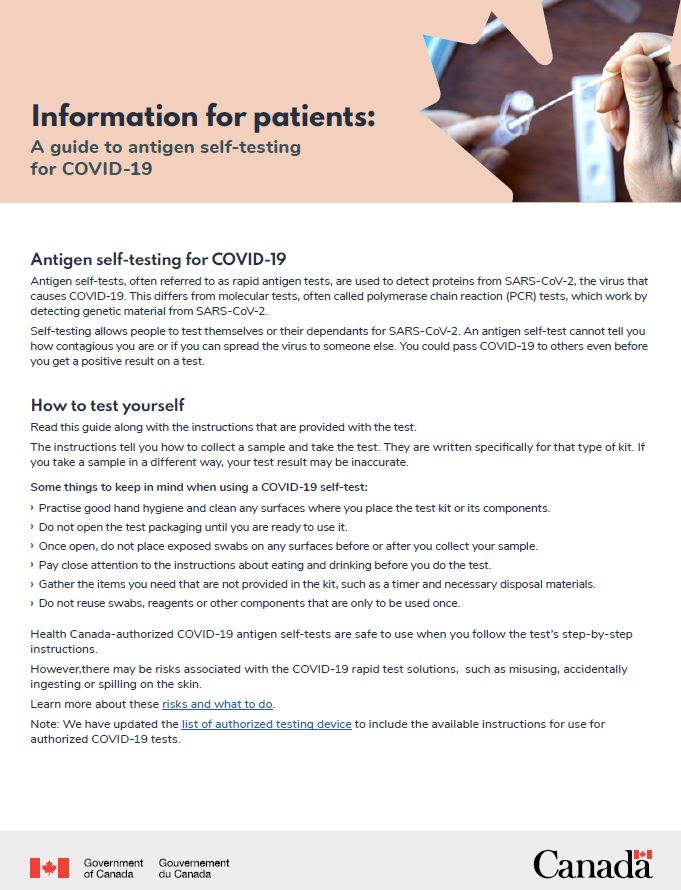Information for patients: A guide to antigen self-testing for COVID-19

Download the alternative format
(PDF format, 177 KB, 2 pages)
Organization: Public Health Agency of Canada
Published: 2023-02-14
On this page
- Antigen self-testing for COVID-19
- How to test yourself
- How to interpret the results
- How to dispose of your test
- How to report your results
Antigen self-testing for COVID-19
Antigen self-tests, often referred to as rapid antigen tests, are used to detect proteins from SARS-CoV-2, the virus that causes COVID-19. This differs from molecular tests, often called polymerase chain reaction (PCR) tests, which work by detecting genetic material from SARS-CoV-2.
Self-testing allows people to test themselves or their dependants for SARS-CoV-2. An antigen self-test cannot tell you how contagious you are or if you can spread the virus to someone else. You could pass COVID-19 to others even before you get a positive result on a test.
How to test yourself
Read this guide along with the instructions that are provided with the test.
The instructions tell you how to collect a sample and take the test. They are written specifically for that type of kit. If you take a sample in a different way, your test result may be inaccurate.
Some things to keep in mind when using a COVID-19 self-test:
- Practise good hand hygiene and clean any surfaces where you place the test kit or its components.
- Do not open the test packaging until you are ready to use it.
- Once open, do not place exposed swabs on any surfaces before or after you collect your sample.
- Pay close attention to the instructions about eating and drinking before you do the test.
- Gather the items you need that are not provided in the kit, such as a timer and necessary disposal materials.
- Do not reuse swabs, reagents or other components that are only to be used once.
Health Canada-authorized COVID-19 antigen self-tests are safe to use when you follow the test’s step-by-step instructions.
However, there may be risks associated with the COVID-19 rapid test solutions, such as misusing, accidentally ingesting or spilling on the skin.
Learn more about these risks and what to do.
Note: We have updated the list of authorized testing device to include the available instructions for use for authorized COVID-19 tests.
How to interpret the results
The results will be displayed either:
- visually as coloured bands (like a pregnancy test) or by a portable reader or
- with the aid of a smartphone application
Follow the instructions provided with the test to determine if your results are positive, negative or invalid.
A positive result
A positive result means the test detected SARS-CoV-2 in your sample. Although you may or may not have any symptoms, it's possible that you could still spread the virus.
Steps to take:
- Follow your local public health guidelines, especially for self-isolation, to limit the spread of COVID-19.
- Contact your local health authority to report a positive result and to book a lab test that will confirm the result as required.
- Contact your health care provider if your symptoms get worse.
A negative result
A negative result means SARS-CoV-2 was not detected in your sample. However, this result does not rule out a SARS-CoV-2 infection. You may still have COVID-19 and you may still be contagious.
To increase the chance that the negative result for COVID-19 is accurate, you should:
- test again in 48 hours if you have symptoms on the first day of testing
- test 2 more times at least 48 hours apart if you do not have symptoms on the first day of testing
Steps to take:
- If any of the repeat tests are positive, you most likely have COVID-19 and should follow current public health measures.
- If all repeat tests are negative and you are concerned you have COVID-19, you may choose to test again using an antigen test or consult with your health care provider regarding molecular testing.
- Continue to follow your local public health guidelines.
- Talk to your health care provider if you have symptoms or suspect you have been in contact with someone who has COVID-19.
An invalid result
An invalid result means that the test was unable to process your sample. The test did not work properly. To reduce the risk of an invalid result, be sure to follow the instructions provided with your test.
Steps to take:
- Get a new COVID-19 test, as self-tests can only be used once.
- Call your local public health office if you are having trouble doing a self-test or have questions about self-testing.
- Contact the manufacturer of the self-test to report the invalid result.
- Follow local public health guidelines to stop the spread of COVID-19.
How to dispose of your test
It's important to dispose of your test properly. To limit the risk to others, you should discard the used test components in accordance with federal, provincial, territorial and local guidelines.
- Check the instructions that came with the test for details on disposal, such as removing the batteries.
- When disposing of the test, place the components into a disposable bag to prevent someone else from coming into contact with the used device.
How to report your results
To find out what you should do if you get a positive, negative or invalid test result, you may need to contact your local health authority. You can also find the most updated information on your provincial or territorial website: